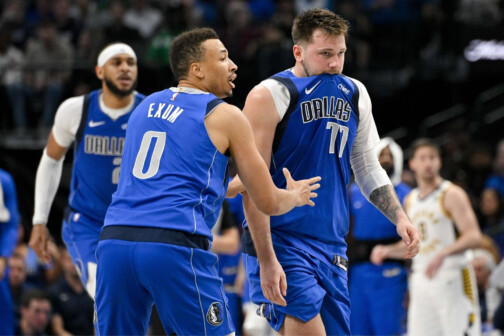We are a month away from the NBA playoffs, and this season is one of the most wide-open in recent memory. Apart from maybe the Phoenix Suns, there are no clear-cut frontrunners. But I’m less interested in the standings and potential matchups than I am at big-picture roster makeups. And whenever I think about which of them is built to win in the playoffs, I remember a talk by Bob Myers, the president of basketball operations and general manager for the Golden State Warriors, at the MIT Sloan Sports Analytics Conference back in 2019. If you want to understand how playoff basketball really works, invest two and a half minutes of your time—from the 14:05 to the 16:35 minute mark—and listen to Myers’ talk.
Myers argues that the regular season and playoffs are two completely different sports. They are officiated differently, teams prepare in new ways, and the rotations are completely changed. The players who succeed in the games that matter most are multidimensional ones who check several boxes. On the other hand, the specialists who do only one thing really well usually struggle.
Why? Because, as Myers put it, “in the playoffs, your first move is gone.” If your only move is to shoot the corner three or to roll to the basket, think what happens when the defense takes that away. This is what happened to the Mavericks when the Los Angeles Clippers put Kawhi Leonard on Kristaps Porzingis in last year’s first-round series. Porzingis ended up watching from the perimeter as the season slipped away. The more breadth a player has to his game, the bigger his bag, the harder he is to take out of the game. Successful playoff performers always find a way to make an impact.
Being the nerd that I am, I tried to figure out if I could quantify that. Could I identify the “boxes” multidimensional players need to check in the playoffs? More important, what would that information mean for the Mavericks—both as far as the players they have and the opponents they could face off against? Again, this is about to get insanely nerdy.
The first step was to find a matching metric for each of Myers’ criteria in this season’s data, minus how a player defends his position (evaluating defense through numbers, even with all the advanced stats available to the public, is much harder to do).
“Can he dribble [and create his own shot]?” I picked unassisted shot rate, or share of unassisted shots.
“Can he pass?” It made sense to settle on assist rate, or assists per offensive possession when a player was on the floor.
“Can he shoot the three?” Three-point rate, of course, or share of a player’s three-point FGA in his overall shot diet.
“Can you get to the line?” I went with free-throw rate, or free-throws per offensive possession when a player is on the floor.
Then I added scoring rate and usage rate on top to highlight players who carry the heavy load on offense. I applied the framework to more than 200 rotation players—I defined this as players who average more than 15 minutes per game—on playoff-contending teams (the top 10 in both conferences). Finally, without getting into the nitty gritty, I grouped similar players to see if we can define different offensive archetypes.
When the dust had settled, five different types of players emerged. They are not ideal; every group has high-end performers and a bottom tier, and you could always go even more granular and divide groups into smaller sub-groups. I also didn’t use efficiency metrics in here, either, because the main goal was to identify archetypes rather than rank a player’s effectiveness within them.
Still, I think the final results offer a pretty good picture of what the Mavs will be dealing with. The full results can be found in the gallery at the top or bottom of this story. Take a scroll through those, then come right back here.
Group 1: Multi-Dimensional Star Players
These are the main hubs on offense. They can create their own shot, and most create for others, too. They can get to the free-throw line and carry the heavy load on offense. Their multidimensionality is easily seen in the charts, where the blue area represents above-average production at a given skill. Look how far these players stretch beyond that, in multiple directions.
Group 2: Secondary Playmakers
Having at least one star player is an obvious must for the playoffs, but secondary playmakers—especially the elite-level ones—can swing a postseason series. They can create their own shot, and more important come playoff time, do the same for others.
Group 3: Volume Scorers
Players in this group score at an above-average rate and do it from different positions on the floor. Most can’t create their own shot at the rate stars and secondary playmakers do, and they don’t really set the table for others. They are play finishers, not play creators. Their multidimensionality comes in the ways they score, not in having other skills to supplement it.
Groups 4 and 5: Specialists
You’ll mostly find the prototypical three-and-D players in Group 4 and rim-running big men in Group 5. The former mostly score from beyond the arc, the latter do it close to the rim and on putbacks. Offensively, players in both groups are specialized role players that rely on others to create for them.
So, what does this tell us about the Mavericks and where they stand in the Western Conference?
First, the competition. Phoenix is the gold standard: the team with the best ball-handling combination, surrounded by top-notch specialists. They have a clear style and players with distinctive roles. (Interestingly, after their trade deadline shakeup, the Mavs are the team with the most similar roster and player archetype setup in the Western Conference—more on that shortly.)
Other teams at the top of the conference—Memphis, Golden State, Utah, Denver, and Minnesota—rely less on the playmaking of their secondary ball-handlers but have more players in Group 3 who can score at a high rate within the flow of the offense. The further we go down in the standings, the more we see teams without top-tier primary and secondary playmaking and shot-creation talent. That’s especially true for the Nuggets, who are missing Jamal Murray, and the Clippers who are without both stars, Kawhi Leonard and Paul George.
As for the Mavericks themselves, Jalen Brunson’s continuous development and the addition of Spencer Dinwiddie have drastically changed their outlook. In Dallas’ last two playoff runs, Luka Doncic was the team’s only playmaker and shot creator. This year, it seems they have three competent ones.
Brunson projects as a top-tier secondary ball-handler, especially if I’d added efficiency to the mix. Dinwiddie does, too, at least using only his Mavericks’ stats. All told, I counted only 33 players that average more than 13 points per game and more than half of their shots unassisted. Doncic, Brunson, and Dinwiddie are three of them, which makes Dallas one of three teams to have a full trio. The other two? Utah and Milwaukee, the latter of whom won the championship in no small part to the many things Giannis Antetokounmpo, Khris Middleton, and Jrue Holiday could do. In fact, if we add playmaking—more than 0.15 assists per minute played—to the criteria, the Mavericks and the Bucks become the only teams with three players who fit the “create-score-pass” profile.
So the Mavericks now have three players who check several boxes, and Jason Kidd does a great job of playing at least two of them on the floor at all times. From the start of the season, Kidd has said he wants “basketball players,” and I think his definition matches Bob Myers’. Mark Cuban recently referenced the Porzingis trade as the step toward shaping the roster to fit Kidd’s style of play, which neatly answers the question how the Mavericks brain trust perceived Porzingis: a high volume scorer—Porzingis landed in Group 3—but not a multidimensional player whose game is bulletproof in the playoffs.
But while the Mavericks now have the West’s second-best playmaking combo after Phoenix, there were some problematic things that came out of this, too. Tim Hardaway Jr.’s injury means the Mavericks don’t have any player outside of the playmaking trio who isn’t a specialist. And I mean specialized: the 20 playoff-contending teams employ only 18 players who play more than 20 minutes per game, have a usage rate lower than 15 percent, and create less than 20 percent of their own shots. The Mavericks have four of them: Dorian Finney-Smith, Maxi Kleber, Reggie Bullock, and Dwight Powell. The Clippers are the only other team with more than two such players. If we remove the minutes criteria, you can add Josh Green and Sterling Brown to the list, too.
These numbers are probably skewed by Doncic’s ball-dominating play, but this will remain a chicken-or-egg question until we see more skilled wing players or big men in the rotation. With the current supporting cast, we’ve seen mixed results when the role players are asked to do things out of their comfort zone. Kidd is encouraging some of them to do more because he knows that, when the playoffs start, teams will try to run his spot-up specialists from the three-point line and make decisions. (The Knicks did exactly that to Dallas on Wednesday, and the 30-point margin of defeat tells the story of how well that went for the Mavericks.) This is why we’ve seen Finney-Smith bring up the ball, drive more often, and even shoot a three after a jab step. Kleber, for his part, is putting the ball on the floor more and trying to attack close-outs by driving to the rim. Maybe Green can eventually develop into a super-charged role player who can dribble, pass, and shoot.
But, so far, none of those players do any of those things well enough to be considered true multidimensional threats. And while having a secondary playmaker on the floor with Doncic at all times certainly helps, the Mavericks just need more. Taking the next step and becoming genuine title contenders means adding a multidimensional wing player or a top-tier big man.
Until then, the improved defense and playmaking upgrades make them much more unpredictable and fun to watch than they were a year ago. Pardon the cliche, but this is a team nobody wants to see when the playoffs come around. Once they do, we’ll find out which Western Conference team is truly built to win.
Get the ItList Newsletter
Author








